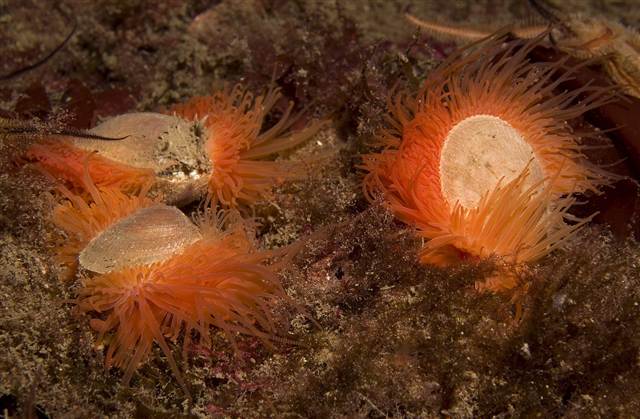It’s the last friday in 2012 so that means the final installment of the Friday Smorgasbord for the year. To kick off the last smorgi post of 2012, we have a massive flame scallop reef off the coast of Scotland that may be the largest of its kind. With at least 100 million of the shellfish with bright-orange tentacles packed into 4.5 square miles, the massive reef has surprised researchers. The reef is located in Loch Alsh, a sea inlet between the Isle of Skye and the Scottish mainland. “This important discovery may be the largest grouping of flame shells anywhere in the world,” Scottish Environment Secretary Richard Lochhead said in the statement.
[via NBC]
[vimeo]http://vimeo.com/55506438[/vimeo]
You probably know somebody that has posted a remarkable image on Facebook of a massive swarm of fish surrounding a diver and now more light is being shed on the source of the image. In this video above, the photographer is a scientist named Octavio Aburto, and the location was Cabo Pulmo National Park, a vast marine reserve in Mexico’s Sea of Cortez and the diver is David Castro, whose family helps enforce rules within the park. The Jack fish in the picture are known to be voracious predators that school in large numbers and they appear in a courtship tornado in this video. Pretty inspiring.
[via NatGeo]
Luis Rocha’s latest installment in the New York Times regarding his research on the social wrasse delves into the problem facing much of the Caribbean and Atlantic region — lionfish. Rocha discusses how prevalent the invasive species in in Belize, finding them in all habitats they visited, including coral reef, sea grass and mangrove. As he notes, finding them in sea grass and mangrove areas is disheartening, “as they are nursery habitats for many coral reef species. Lionfish are eating young reef fish before they can even get there.” So if you visit any of these areas, make sure to do your part to help harvest this fish.
[via New York Times]

An interesting development in a 100-megawatt power plant that uses differences in ocean temperature to create energy may have this technology closer to becoming a reality. The closed system uses warm surface water to boil liquid ammonia creating steam to rise and power a turbine to create the electricity. Cooler water is drawn from a kilometer below the floating platform to cool the vapor and return it to liquid form to repeat the process. The trouble rose when the warmer water was discharged back into the ocean in depths that caused algae blooms, but research has found that if the warmer water is returned 70 meters below the surface, no algae blooms will form.
[via Greentech Media]




